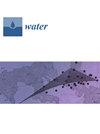通过时间序列分析估算墨西哥奇瓦瓦州梅奥基市的饮用水消耗量
IF 3
3区 环境科学与生态学
Q2 ENVIRONMENTAL SCIENCES
引用次数: 0
摘要
水是维持生命的重要资源,也是转型工业众多流程的重要资源。尽管它可以再生,但却是一种有限的资源,因此必须进行可持续管理。为了实现这一目标,有必要使用适当的工具来协助制定水资源管理的规划政策。本文介绍了一种时间序列分析方法,利用 2011 年至 2023 年的数据测量和预测墨西哥奇瓦瓦州梅奥基市各子行业(家庭、商业、公共部门、教育、工业和原水)的人类用水模式和总用水量,并应用校准模型技术测量预测中的不确定性。梅奥基市面积为 342 平方公里。这里属于半干旱气候,年平均降雨量为 272 毫米,夏季平均气温为 26.4 °C,冬季平均气温为 9.7 °C。该市人口为 23 140 人,由 10 口水井供水,每个用户的平均用水量为 20±579 立方米。普通居民的用水量表明存在一个季节性自回归综合移动平均(SARIMA)(0,1,2)(0,0,2)12 模型。(森氏斜率 = 682.7,p < 0.001)。国内部门的总消费量最高,为 17 169 009 立方米(13 ± 93)。估计的 SARIMA (2,1,0)(2,0,0)12 模型的森斜率为 221.65,P 值小于 0.001。总耗水量第二大的行业是 "原水 "行业,耗水量为 5,124,795 (30,146 ± 35,841) 立方米,其 SARIMA (0,1,1)(2,0,0)12 模型在统计上没有显著趋势。由此产生的模型将有助于公司根据预计的消耗趋势,以可持续的方式制定水资源管理战略。本文章由计算机程序翻译,如有差异,请以英文原文为准。
Time Series Analysis to Estimate the Volume of Drinking Water Consumption in the City of Meoqui, Chihuahua, Mexico
Water is a vital resource for sustaining life and for numerous processes within the transformation industry. It is a finite resource, albeit one that can be renewed, and thus sustainable management is imperative. To achieve this objective, it is necessary to have the appropriate tools to assist with the planning policies for its management. This paper presents a time series analysis approach to measure and predict the pattern of water consumption by humans throughout subsectors (domestic, commercial, public sector, education, industry, and raw water) and total water consumption in Meoqui, Chihuahua, Mexico with data from 2011 to 2023, applying calibration model techniques to measure uncertainty in the forecasting. The municipality of Meoqui encompasses an area of 342 km2. The climate is semi-arid, with an average annual rainfall of 272 mm and average temperatures of 26.4 °C in summer and 9.7 °C in winter. The municipal seat, which has a population of 23,140, is supplied with water from ten wells, with an average consumption of 20 ± 579 m3 per user. The consumption of the general population indicates the existence of a seasonal autoregressive integrated moving average (SARIMA) (0,1,2)(0,0,2)12 model. (Sen’s Slope = 682.7, p < 0.001). The domestic sector exhibited the highest overall consumption, with a total volume of 17,169,009 m3 (13 ± 93). A SARIMA (2,1,0)(2,0,0)12 model was estimated, with a Sen’s slope of 221.65 and a p-value of less than 0.001. The second-largest consumer of total water was the “raw water” sector, which consumed 5,124,795 (30,146 ± 35,841) m3 and exhibited an SARIMA (0,1,1)(2,0,0)12 model with no statistically significant trend. The resulting models will facilitate the company’s ability to define water resource management strategies in a sustainable manner, in alignment with projected consumption trends.
求助全文
通过发布文献求助,成功后即可免费获取论文全文。
去求助
来源期刊

Water
WATER RESOURCES-
CiteScore
5.80
自引率
14.70%
发文量
3491
审稿时长
19.85 days
期刊介绍:
Water (ISSN 2073-4441) is an international and cross-disciplinary scholarly journal covering all aspects of water including water science and technology, and the hydrology, ecology and management of water resources. It publishes regular research papers, critical reviews and short communications, and there is no restriction on the length of the papers. Our aim is to encourage scientists to publish their experimental and theoretical research in as much detail as possible. Full experimental and/or methodical details must be provided for research articles. Computed data or files regarding the full details of the experimental procedure, if unable to be published in a normal way, can be deposited as supplementary material.
 求助内容:
求助内容: 应助结果提醒方式:
应助结果提醒方式:


